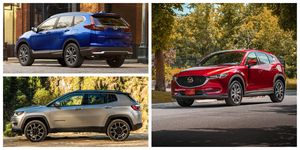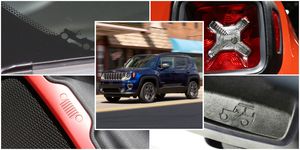From the January 1996 issue of Car and Driver.
Japanese car companies have a penchant for coming up with peculiar names for their products, and X90 is one of them. This randomly generated tag could just as easily be slapped on a CD player or a condom. What Suzuki should have called its new sport-ute is the Platypus. The name fits, and Americans like cars with cute animal names.
A platypus is what comes out when a duck and a beaver are tossed into the mating blender. And the X90 is something like that: it’s a mini off-roader morphed with a sporty car, a Jeep-meets-del Sol kind of two-passenger thing that’s unlike anything else. So much so that we put it on our cover last May and declared it, along with some other similar “funsters,” the “Next Big Thing.”
Now, having driven a production model up the side of a mountain in Washington, down the equally treacherous Interstate 94 in Michigan, and over many kinds of byways in between, we stand by our original judgment. Yes, the X90 (okay, we’ll call it that, but we won’t like it) is the Next Big Thing, but in a very small way.
Suzuki says it hopes to produce 2000 X90s a month, most of which will be sent to the U.S. That’s hardly enough to fuel a trend but sufficient to satisfy the wacky few who will find the X90’s quirky charms irresistible. These people are out there. Suzuki found them with the ill-fated Samurai, which accounted for 81,349 sales in its peak year of 1987. The following year, to Suzuki’s everlasting regret, some character assassins, masquerading as the staffs of Consumer Reports and the Center for Auto Safety, claimed that the Samurai was easier to flip than a toilet seat. Sales went down the tube. Though the National Highway Traffic Safety Administration later vindicated the Samurai and slapped Consumer Reports’ wrist, the Samurai went on life support and never recovered.
This memory no doubt lingered in the minds of Suzuki’s designers when they dreamed up the X90. Whereas the Samurai was a shade above a tractor in refinement, the X90 is a fully realized contemporary automobile, with driver and passenger airbags, side-impact beams, standard four-wheel anti-lock brakes, and a substantial trunk with a full-size spare. But this modernization comes at a cost: the $16,288 sticker on our full-dress X90 is about double what the Samurai cost in 1987.
It’s easy to see where the money went. The X90’s accommodations are first cabin and Camryesque in execution. There’s plenty of space for two—but only two—in comfortable, well-bolstered seats with lots of elbow- and legroom, although a left-foot rest for the driver is notable by its not being there. The instruments are housed in the customary half-moon cluster and the controls are within easy reach. The manual-transmission shifter, which is rooted well forward on the drive line tunnel, is somewhat trucklike, with fairly long throws. But the steering is light, the standard anti-lock brakes perform adequately (considering the off-road-oriented tires), and the ambience of the X90 is that of an up-to-date sports coupe.
The style of the X90 has none of the old Samurai’s flat planes or the squared-off, bush-busting look of current sport-utilities. It looks like a fat puppy, which is to say downright cute and cuddly. The X90 is an attention-getter that draws “What the hell is that?” stares from pop-eyed passers-by. Perplexed smiles invariably follow.
The X90’s curvy body, which was often likened to a “comic-book car” by our Ten Best test crew last September, is bolted to the same platform that’s under Suzuki’s two-door Sidekick. It’s a solid union that makes the car feel as stiff as a frozen flounder. There’s no apparent flexiness, cowl shake, or strange body contortions of the kind often found in cars with T-tops.
This stiffness is carried a degree too far with the suspension, however. With struts in front and a coil-sprung solid axle in the rear, the X90’s underpinnings are conventional, but the springs and dampers are tuned more to suit a pickup than a car.
The X90 has a hard ride that’s aggravated by its short wheelbase. While 86.6 inches might be a great dimension for an NBA center, it is shortish for a car. This makes for a ride that’s more rat-a-tat than bump-de-bump. Expansion strips, potholes, asphalt ripples—the normal skin rash of American roads—play a raucous symphony inside the X90. But then, the X90 makes no pretensions to sedan comfort. It’s truckish and proud of it, which means you may want to leave it at home when the long, open road beckons.
For normal use—running errands, commuting, shopping, and the aimless sort of driving people do most of the time—the X90 is more than satisfactory. Its SOHC, 16-valve, 1.6-liter four-cylinder engine revs quickly to the red line and can easily be kept in the power band with persistent manipulation of its standard five-speed gearbox.
But with only 95 horsepower and a final-drive ratio of 4.63:1, the X90 runs out of zip quickly. Paradoxically, this makes it more fun to drive, because the car reaches its limits almost within those prescribed by the law; it can be pushed hard without much fear of speeding. The 0-to-60-mph dash takes 10.8 seconds in an X90, and top speed is 94 mph.
On a deserted twisty road in the Mount Baker-Snoqualmie National Forest in Washington, with the engine screaming and the tires chirping, the X90 felt like it was going 90, but the speedo needle was barely touching 50. On I-94, 65 mph in fifth (about 3500 rpm) felt like 80. The X90 seems happiest in the 50-to-60-mph range.
Off-road, speed considerations are beside the point. Climbing a steep, rocky path up the side of mist-covered Winchester Mountain in the Cascades, where Suzuki previewed the X90 for the press, it was nimble and surefooted. With four-wheel drive engaged, it stepped over and through loose shale, dry stream beds, blind switchbacks, and first-gear inclines without a wheeze or complaint.
All these practical considerations are beside the point. People will either love or hate the X90. Its appeal is emotional, and that isn’t something that can be quantified in a road test.
Counterpoints
The X90 just makes me wanna grow dimples, cock my head to one side, and wrinkle my little turned-up nose every time I sit behind the wheel. For a moment I may even forget that the kidney-belt ride suggests where Suzuki hid all those leftover Samurai suspension parts, that the tires are useless for serious off-roading, and that only judicious shifting keeps me out in front of 18-wheelers on the interstate. Certainly I salute the T -tops, and the tight turning circle helps me squeeze into that narrow space in front of the sorority house, but what if I actually had to rely on this X90 for daily transportation? Yikes! —Steven Cole Smith
If anyone could drive this beachcombing golf cart and step away with his manhood intact, I figured it’d be “Baywatch’s” David Hasselhoff. So when my tum at the helm came, I peeled off the T -tops, loaded up on the sunscreen, and headed for the sun, just as Dave would. Did I have a blast? I did not. I couldn’t bring an umbrella or a big cooler—not enough trunk room. With only 95 hp, I couldn’t run rings around a wet Coke can. I couldn’t even get a thumbs-up for the cartoonish stance. One girl did take a closer look. She pointed. And giggled. Bummer—instant emasculation. Back to Earth, Dave. —Martin Padgett Jr.
I’d buy an impractical car for the sound of an engine, the curve of a fender, or the thrill of a drive. But I’d never cough up the dough for this Suzuki. It possesses no qualities that allow me to overlook its lone two seats. Built on a truck chassis, it drives like one. Sure, it has part-time four-wheel drive, but that seldom gets used. In the meantime, the car bounces around and turns in lazily. There’s no curve of the fender—or any other body part—that draws me to the X90. Shock value doesn’t rate in my book. —Larry Webster
This content is created and maintained by a third party, and imported onto this page to help users provide their email addresses. You may be able to find more information about this and similar content at piano.io












